Physical Address
304 North Cardinal St.
Dorchester Center, MA 02124
Physical Address
304 North Cardinal St.
Dorchester Center, MA 02124
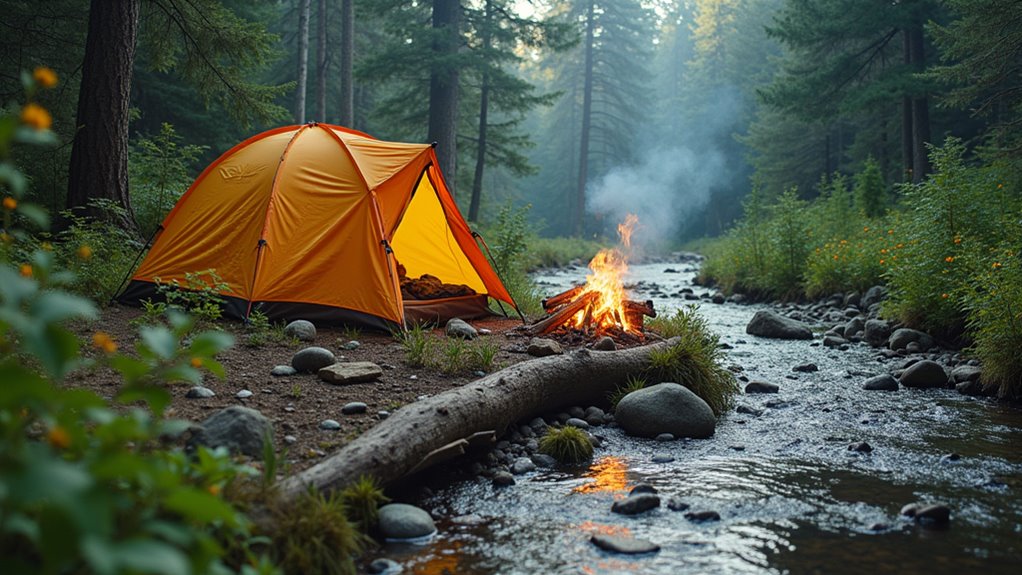
Wondering what critical camping mistakes could turn your outdoor adventure into a dangerous nightmare that leaves you stranded and unsafe?
You’ve packed your gear, mapped your route, and can’t wait to escape into nature’s embrace. But here’s the thing – even experienced campers make critical mistakes that can transform an amazing adventure into a nightmare scenario. These aren’t just minor inconveniences we’re talking about; they’re potentially dangerous oversights that could compromise your safety, damage the environment, or leave you stranded miles from help. Let’s examine what you absolutely must avoid.
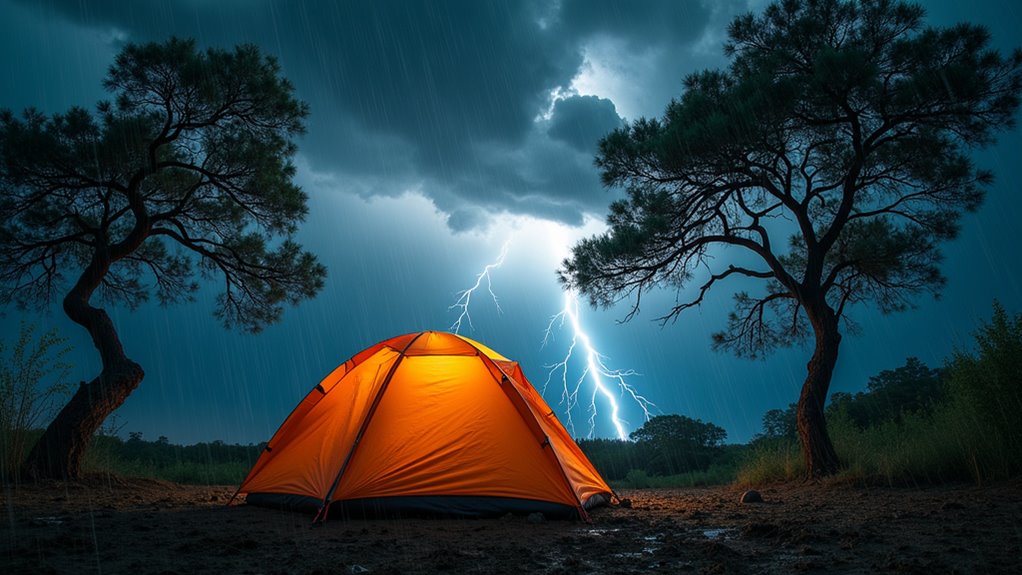
While you can’t control Mother Nature, you can certainly prepare for what she’s planning to throw your way. Checking weather forecasts before and during your camping trip isn’t optional—it’s essential for your safety and comfort. Don’t assume that sunny skies will last or that light rain won’t turn into a dangerous storm.
Download weather apps that work offline and check conditions multiple times daily. Pack appropriate gear for expected weather changes, including extra layers, waterproof clothing, and emergency shelter.
If severe weather’s approaching, don’t stubbornly stick to your original plans. Move to safer ground, seek shelter, or cut your trip short if necessary. Ignoring weather warnings can lead to hypothermia, flash floods, or getting stranded in dangerous conditions.
This is especially important when camping in Minnesota, where weather conditions can change rapidly and dramatically impact your outdoor activities and safety.
Nothing attracts unwanted wildlife visitors faster than the smell of improperly stored food wafting through your campsite. Bears, raccoons, and other animals can detect food odors from miles away, turning your peaceful getaway into a dangerous encounter.
Always store food in bear-proof containers or hang it at least 12 feet high and 4 feet from tree trunks. Don’t leave coolers, snacks, or dirty dishes outside your tent overnight. Even toiletries and scented items need proper storage since animals can’t distinguish between food and soap.
Clean up immediately after meals and pack out all trash. Store everything in your vehicle if bear canisters aren’t available. Remember, feeding wildlife—even accidentally—changes their behavior and puts future campers at risk.
Proper food storage becomes even more critical during winter camping when keeping tents dry requires sealed containers that prevent both moisture and odors from escaping.
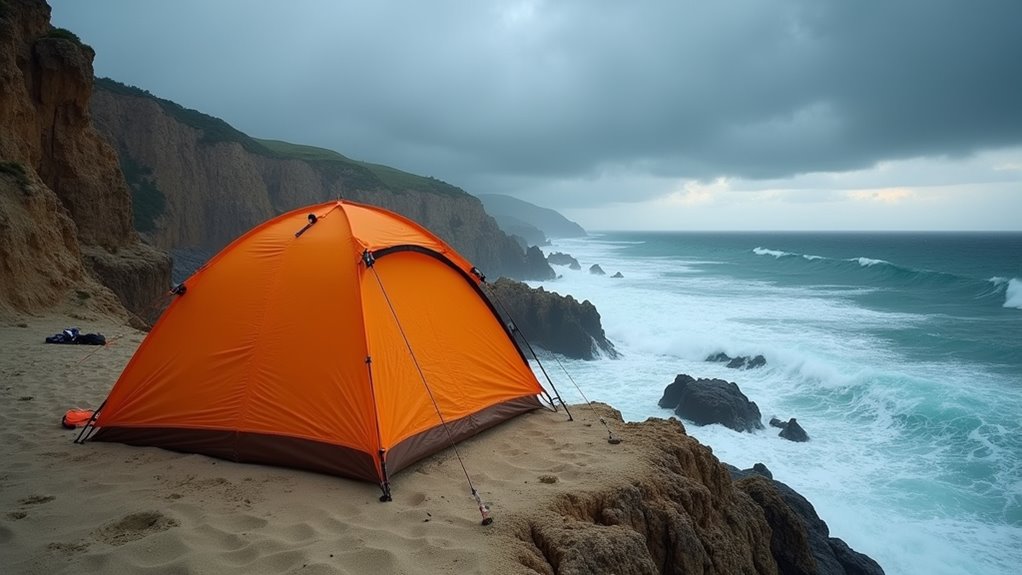
Although that perfect spot by the creek might look picturesque, choosing the wrong campsite location can turn your outdoor adventure into a nightmare—or worse, a life-threatening situation.
Avoid camping directly beside rivers or streams, as flash floods can occur without warning. Don’t pitch your tent in low-lying areas where water naturally collects during storms. Skip hillsides and ridgetops during thunderstorm season—you’ll become a lightning magnet.
Stay away from dead trees or loose rock formations that could fall and crush your tent. Don’t camp too close to animal trails or watering holes, as you’ll attract unwanted nocturnal visitors. Check for ant hills, wasp nests, and poisonous plants before setting up.
Choose elevated, flat ground that’s naturally sheltered from prevailing winds but still allows proper drainage. When selecting your campsite in destinations like Alpine, Wyoming, research the specific terrain and weather patterns of the area beforehand.
Finding the perfect campsite won’t matter if your tent collapses in the middle of the night or your stove refuses to light when you’re starving. Test every piece of equipment at home before you leave. Set up your tent completely, checking for missing stakes, broken zippers, or torn fabric.
Fire up your camp stove and cook a meal to ensure it’s working properly. Test your flashlights, headlamps, and any battery-powered devices. Check your sleeping bag’s zipper and inspect it for holes or worn spots.
Verify that your water filter functions correctly and your first aid supplies aren’t expired. Don’t forget to test your camping kitchen setup as well, ensuring all cooking utensils, storage containers, and prep surfaces are organized and functional. This twenty-minute gear check can prevent major disasters and salvage your entire camping experience.
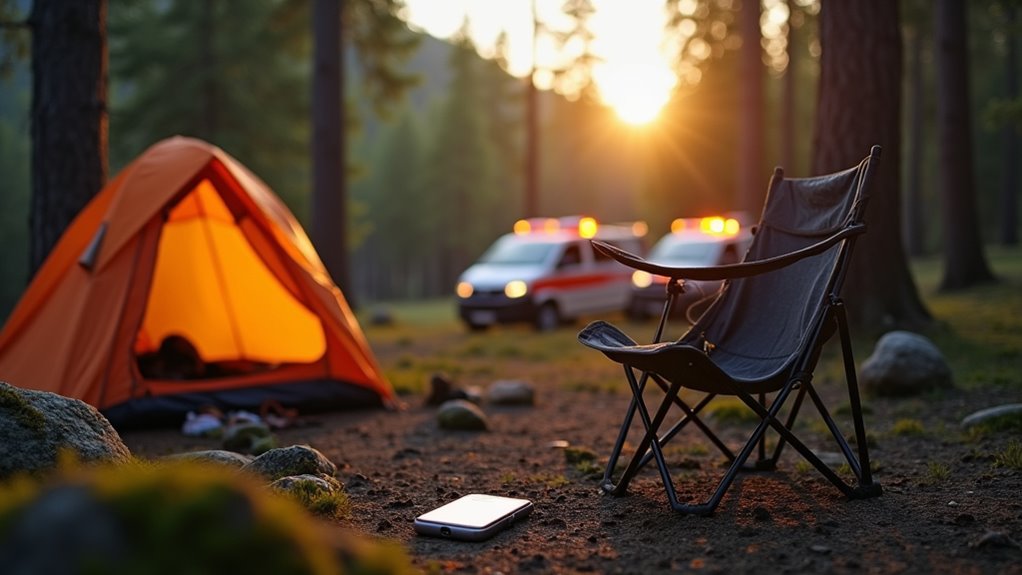
When you disappear into the wilderness without telling anyone your destination or expected return, you’re fundamentally rolling the dice with your safety. Share your complete itinerary with trusted friends or family members, including trailheads, campsites, and backup routes. Don’t just say “going camping” – provide specific locations, GPS coordinates if possible, and your planned timeline.
Leave detailed information about your vehicle’s make, model, color, and license plate. Include emergency contact numbers and any medical conditions rescuers should know about. Set a firm check-in time and stick to it. If you’re delayed, contact your emergency contacts immediately.
Consider filing a trip plan with local rangers or park services. This creates an official record that’ll trigger search protocols if you don’t return as scheduled. Before finalizing your plans, take time to determine your ideal camping style to ensure you’re adequately prepared for the specific challenges and requirements of your chosen outdoor experience.
Water mistakes kill more campers than almost any other oversight, yet people consistently pack half of what they actually need. You’ll need at least one gallon per person daily for drinking, cooking, and basic hygiene – double that in hot weather or high altitudes.
Don’t rely on finding water sources along your route. Springs dry up, streams get contaminated, and that “reliable” creek might be a muddy trickle when you arrive. Pack extra water beyond your calculated needs, plus purification tablets or a quality filter as backup.
Watch for dehydration signs: headaches, dizziness, dark urine, and fatigue. These symptoms worsen rapidly in outdoor conditions. Start hydrating before you feel thirsty, and drink consistently throughout the day rather than chugging large amounts sporadically.
Winter camping presents unique challenges where water treatment becomes even more critical as traditional purification methods may fail in freezing temperatures.
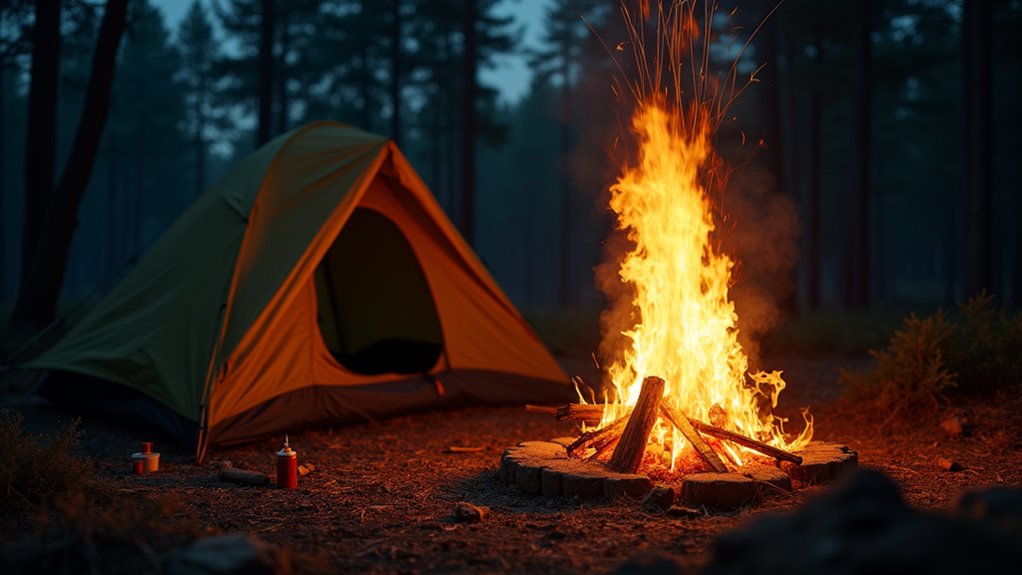
Campfires can turn from cozy gathering spots into deadly disasters faster than you’d expect, claiming thousands of acres and lives each year through preventable accidents. You’ll need a fire extinguisher, shovel, and bucket of water within arm’s reach before lighting anything.
Clear a ten-foot radius of flammable debris, dig your fire pit down to mineral soil, and surround it with rocks.
Never leave flames unattended—not even for bathroom breaks. When you’re ready to sleep, douse the fire completely with water, stir the ashes, then add more water until everything’s cold to touch.
Check local fire restrictions and weather conditions beforehand, as many areas ban fires during dry seasons. If you’re camping with dogs, keep them on leash near the fire area since they can accidentally knock over equipment or get too close to flames.
While you’re enjoying nature’s beauty, you’re also responsible for preserving it for future campers through the Leave No Trace principles. Don’t camp on fragile vegetation or create new campsites—stick to established areas.
You shouldn’t leave food scraps, even biodegradable ones like banana peels, as they disrupt wildlife behavior and natural decomposition processes. Don’t build rock cairns or move natural features for Instagram shots.
Pack out everything you brought in, including toilet paper and hygiene products. Avoid picking flowers, collecting rocks, or disturbing wildlife for photos.
Don’t wash dishes or brush teeth directly in water sources—use a portable basin and scatter greywater 200 feet away. When selecting where to set up camp, research the area beforehand to ensure you choose an ideal camping spot that minimizes environmental impact. These principles guarantee wilderness areas remain pristine for everyone.
You’ll face nature’s raw beauty and unforgiving power on every camping trip. While sunset views reward your careful planning, one overlooked safety measure can turn paradise into peril. You’ve learned the essential don’ts—now it’s your responsibility to practice them. The wilderness doesn’t forgive shortcuts or careless mistakes. Remember, you’re not conquering nature; you’re respectfully visiting it. Pack smart, stay alert, and you’ll create memories that last a lifetime instead of regrets you can’t undo.